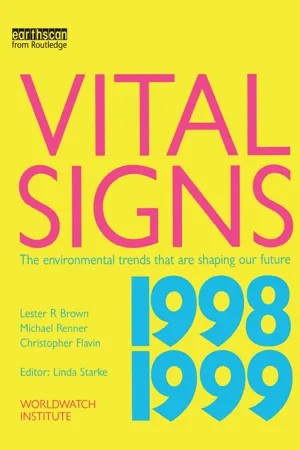
Vital Signs 1998-1999
The Environmental Trends That Are Shaping Our Future
Lester R. Brown
- 142 pagine
- English
- ePUB (disponibile sull'app)
- Disponibile su iOS e Android
Vital Signs 1998-1999
The Environmental Trends That Are Shaping Our Future
Lester R. Brown
Informazioni sul libro
First Published in 1998. In this seventh annual edition of VITAL SIGNS the team at the Worldwatch Institute bring together an eclectic selection of disparate trends to offer a unique, multifaceted view of our rapidly changing world. This vital resource and reference guide traces the scientific, social, economic and environmental trends that have and continue to shape our world. Among the trends covered for the first time in VITAL SIGNS 1998-99, are frontier forests, plantation forestry, satellite launches, minerals exploration, small arms proliferation and female education. This year's edition points out that global emissions of carbon, the leading contributor to global climate change, hit another new high, while wind power has grown an amazing 26 per cent per year, and sales of solar cells jumped a phenomenal 43 per cent in 1997. VITAL SIGNS is the most comprehensive source of environmental and social information available.
Domande frequenti
Informazioni
Trends
Grain Harvest Up Slightly |
Indice dei contenuti
- Cover
- Half Title
- Title Page
- Copyright Page
- Table of Contents
- ACKNOWLEDGEMENTS
- FOREWORD
- OVERVIEW: NEW RECORDS, NEW STRESSES
- Part One: KEY INDICATORS
- Part Two: SPECIAL FEATURES
- NOTES
- THE VITAL SIGNS SERIES